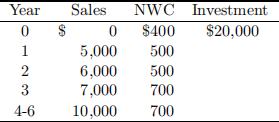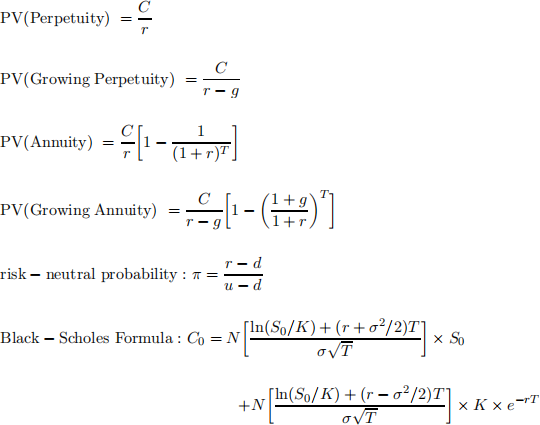ECON6033 Corporate Finance 2020-2021 Examination
Hello, dear friend, you can consult us at any time if you have any questions, add WeChat: daixieit
Master ofEconomics
2020-2021 Examination
ECON6033 Corporate Finance
Some useful formulas:
Answer ALL questions.
1. (20%) Mr. Wong bought an apartment at a price of $3,000,000 on January 1, 2013. He borrowed 70% of the property value from Hang Seng Bank at that time. The ![]() rst monthly installment was due on January 31, 2013. The mortgage is a
rst monthly installment was due on January 31, 2013. The mortgage is a ![]() oating-rate one and has a maturity of 10 years. The interest rate on the loan is set equal to the prime rate minus 1.5%.
oating-rate one and has a maturity of 10 years. The interest rate on the loan is set equal to the prime rate minus 1.5%.
On October 1, 2019, Mr. Wong’s apartment had a market value of $4,000,000. Mr. Wong talked to Hang Seng Bank to arrange a new mortgage to replace the old one. In the new mortgage, Mr. Wong borrowed 70% of the market value of his apartment. The new mortgage has a maturity of 20 years with the ![]() rst monthly installment due on October 31, 2019. The interest rate is set equal to the prime rate minus 2.5%. The prime rate has been constant at 5% from January 2013 to October 2019.
rst monthly installment due on October 31, 2019. The interest rate is set equal to the prime rate minus 2.5%. The prime rate has been constant at 5% from January 2013 to October 2019.
(a) What is the monthly installment of the original mortgage?
(b) How much would Mr. Wong receive from Hang Seng Bank when the new mort- gage was arranged to replace the old one on October 1, 2019?
(c) What is the monthly installment of the new mortgage?
2. (20%) An investment bank is o![]() ering a new
ering a new ![]() nancial instrument called a “happy call” on HSBC with an exercise price of $55. Three months from now the contract expires and the holder has a choice between receiving half a share of HSBC for free and buying one share at the exercise price. The holder always gets something with the happy call. The current stock price of HSBC is $60. Two European call options on HSBC with exercise prices, $55 and $110, both of which expire three months from now, are trading at $7 and $2, respectively. The riskless rate of interest rate is 5% per year. What is the fair price of the happy call?
nancial instrument called a “happy call” on HSBC with an exercise price of $55. Three months from now the contract expires and the holder has a choice between receiving half a share of HSBC for free and buying one share at the exercise price. The holder always gets something with the happy call. The current stock price of HSBC is $60. Two European call options on HSBC with exercise prices, $55 and $110, both of which expire three months from now, are trading at $7 and $2, respectively. The riskless rate of interest rate is 5% per year. What is the fair price of the happy call?
3. (30%) Deciduous Inc. is deciding whether or not to enter the aluminum siding busi- ness. Projected sales, total net working capital (NWC) requirements, and capital investments are:

Variable costs are 60% of sales, and ![]() xed costs are negligible. The $20,000 in produc- tion equipment will be depreciated on a straight-line basis, to a value of zero, over a
xed costs are negligible. The $20,000 in produc- tion equipment will be depreciated on a straight-line basis, to a value of zero, over a ![]() ve-year period. The equipment will actually be worth $10,000 if salvaged in six years. The required rate of return is 10% and the
ve-year period. The equipment will actually be worth $10,000 if salvaged in six years. The required rate of return is 10% and the ![]() rm’s tax rate is 34%. Should Deciduous embark on this new line of business?
rm’s tax rate is 34%. Should Deciduous embark on this new line of business?
4. (30%) Consider a ![]() rm whose current marker value is $150 at the beginning of the
rm whose current marker value is $150 at the beginning of the ![]() rst period. The
rst period. The ![]() rm lasts for two periods. The rate of return on the
rm lasts for two periods. The rate of return on the ![]() rm’s assets over each period is equally likely to be either 20% or
rm’s assets over each period is equally likely to be either 20% or ![]() 20%. The risk-free rate is 5% in each period. If any cash payout, coupon and/or dividend, is made at the end of the
20%. The risk-free rate is 5% in each period. If any cash payout, coupon and/or dividend, is made at the end of the ![]() rst period, then the ex-payout
rst period, then the ex-payout ![]() rm value will change by either 20% or
rm value will change by either 20% or ![]() 20% over the second period. There are no taxes and bankruptcy costs.
20% over the second period. There are no taxes and bankruptcy costs.
(a) At the beginning of the ![]() rst period, the
rst period, the ![]() rm issues a coupon bond and pays out the proceeds as dividends to shareholders. The bond has a face value of $100 and a per-period coupon rate of 6% to be matured at the end of the second period. The
rm issues a coupon bond and pays out the proceeds as dividends to shareholders. The bond has a face value of $100 and a per-period coupon rate of 6% to be matured at the end of the second period. The ![]() rm pays no dividends at the end of the
rm pays no dividends at the end of the ![]() rst period. What is the market value of the bond at the beginning of the
rst period. What is the market value of the bond at the beginning of the ![]() rst period?
rst period?
(b) Consider now that the ![]() rm can choose between two sets of assets with the same initial value of $150. The
rm can choose between two sets of assets with the same initial value of $150. The ![]() rst set of assets is as described above, which has the rate of return over each period equally likely to be either 20% or
rst set of assets is as described above, which has the rate of return over each period equally likely to be either 20% or ![]() 20%. The second set of assets, on the other hand, has the rate of return over each period equally likely to be either 35% or
20%. The second set of assets, on the other hand, has the rate of return over each period equally likely to be either 35% or ![]() 35%. The choice of the set of assets by the
35%. The choice of the set of assets by the ![]() rm is unobservable to outsiders, and thereby non-contractable. The
rm is unobservable to outsiders, and thereby non-contractable. The ![]() rm chooses the set of assets to maximize the value of equity. This objective is known to outsiders. Redo part (a).
rm chooses the set of assets to maximize the value of equity. This objective is known to outsiders. Redo part (a).
2022-01-26
